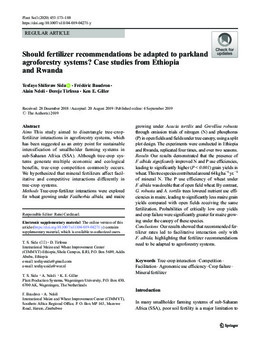Mostrar el registro sencillo del ítem
Should fertilizer recommendations be adapted to parkland agroforestry systems? Case studies from Ethiopia and Rwanda
| Autor: | Sida, T.S. |
| Autor: | Baudron, F. |
| Autor: | Ndoli, A. |
| Autor: | Tirfessa, D. |
| Autor: | Giller, K.E. |
| Año: | 2019 |
| ISSN: | 0032-079X |
| ISSN: | 1573-5036 (Online) |
| URI: | https://hdl.handle.net/10883/20589 |
| Resumen: | Aims This study aimed to disentangle tree-crop fertilizer interactions in agroforestry systems, which has been suggested as an entry point for sustainable intensification of smallholder farming systems in sub-Saharan Africa (SSA). Although tree-crop systems generate multiple economic and ecological benefits, tree-crop competition commonly occurs. We hypothesized that mineral fertilizers affect facilitative and competitive interactions differently in tree-crop systems. Methods Tree-crop-fertilizer interactions were explored for wheat growing under Faidherbia albida, and maize growing under Acacia tortilis and Grevillea robusta through omission trials of nitrogen (N) and phosphorus (P) in open fields and fields under tree canopy, using a split plot design. The experiments were conducted in Ethiopia and Rwanda, replicated four times, and over two seasons. Results Our results demonstrated that the presence of F. albida significantly improved N and P use efficiencies, leading to significantly higher (P < 0.001) grain yields in wheat. This tree species contributed around 64 kg ha−1 yr.−1 of mineral N. The P use efficiency of wheat under F. albida was double that of open field wheat. By contrast, G. robusta and A. tortilis trees lowered nutrient use efficiencies in maize, leading to significantly less maize grain yields compared with open fields receiving the same fertilization. Probabilities of critically low crop yields and crop failure were significantly greater for maize growing under the canopy of these species. Conclusions Our results showed that recommended fertilizer rates led to facilitative interaction only with F. albida, highlighting that fertilizer recommendations need to be adapted to agroforestry systems. |
| Formato: | |
| Lenguaje: | English |
| Editor: | Springer Verlag |
| Copyright: | CIMMYT manages Intellectual Assets as International Public Goods. The user is free to download, print, store and share this work. In case you want to translate or create any other derivative work and share or distribute such translation/derivative work, please contact CIMMYT-Knowledge-Center@cgiar.org indicating the work you want to use and the kind of use you intend; CIMMYT will contact you with the suitable license for that purpose. |
| Tipo: | Article |
| Lugar de publicación: | Dordrecht (Netherlands) |
| Páginas: | 173-188 |
| Número: | 1-2 |
| Volumen: | 453 |
| DOI: | 10.1007/s11104-019-04271-y |
| País: | ETHIOPIA |
| País: | RWANDA |
| Agrovoc: | TREES |
| Agrovoc: | CROPS |
| Agrovoc: | PLANT COMPETITION |
| Agrovoc: | FACILITATION |
| Agrovoc: | INORGANIC FERTILIZERS |
| Datasets relacionados: | https://link.springer.com/article/10.1007/s11104-019-04271-y#Sec18 |
| Revista: | Plant and Soil |
Ficheros en el ítem
Este ítem aparece en la(s) siguiente(s) colección(ones)
-
Sustainable Intensification
Sustainable intensification agriculture including topics on cropping systems, agronomy, soil, mechanization, precision agriculture, etc.

